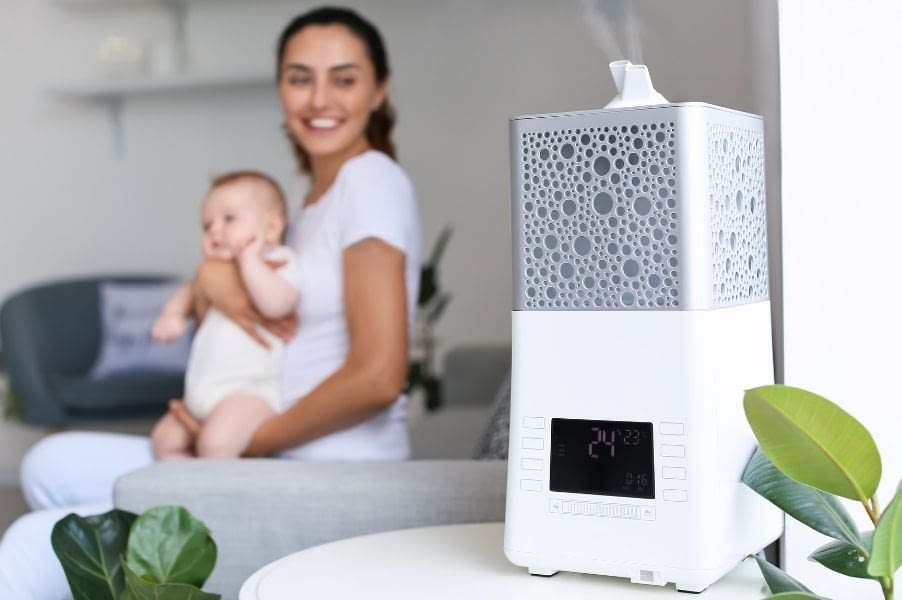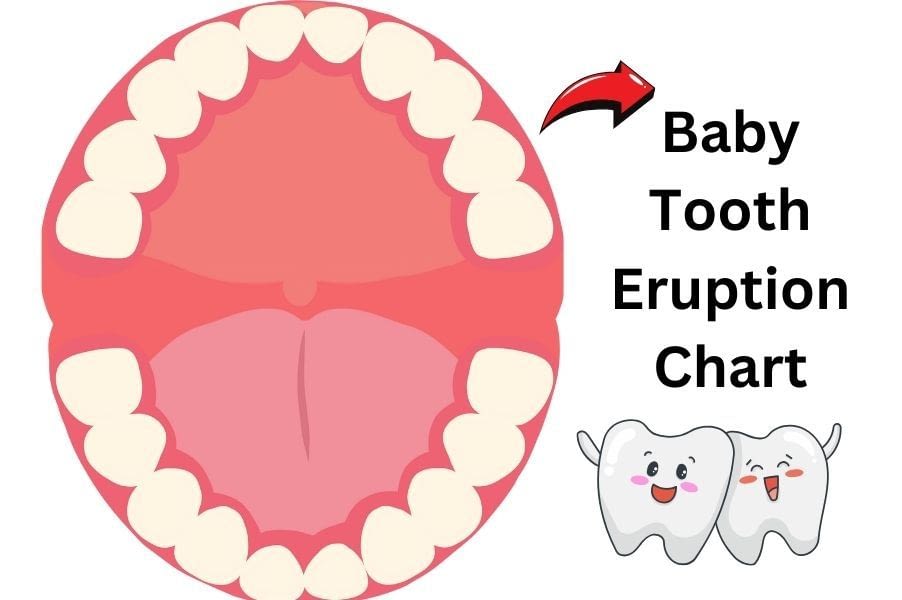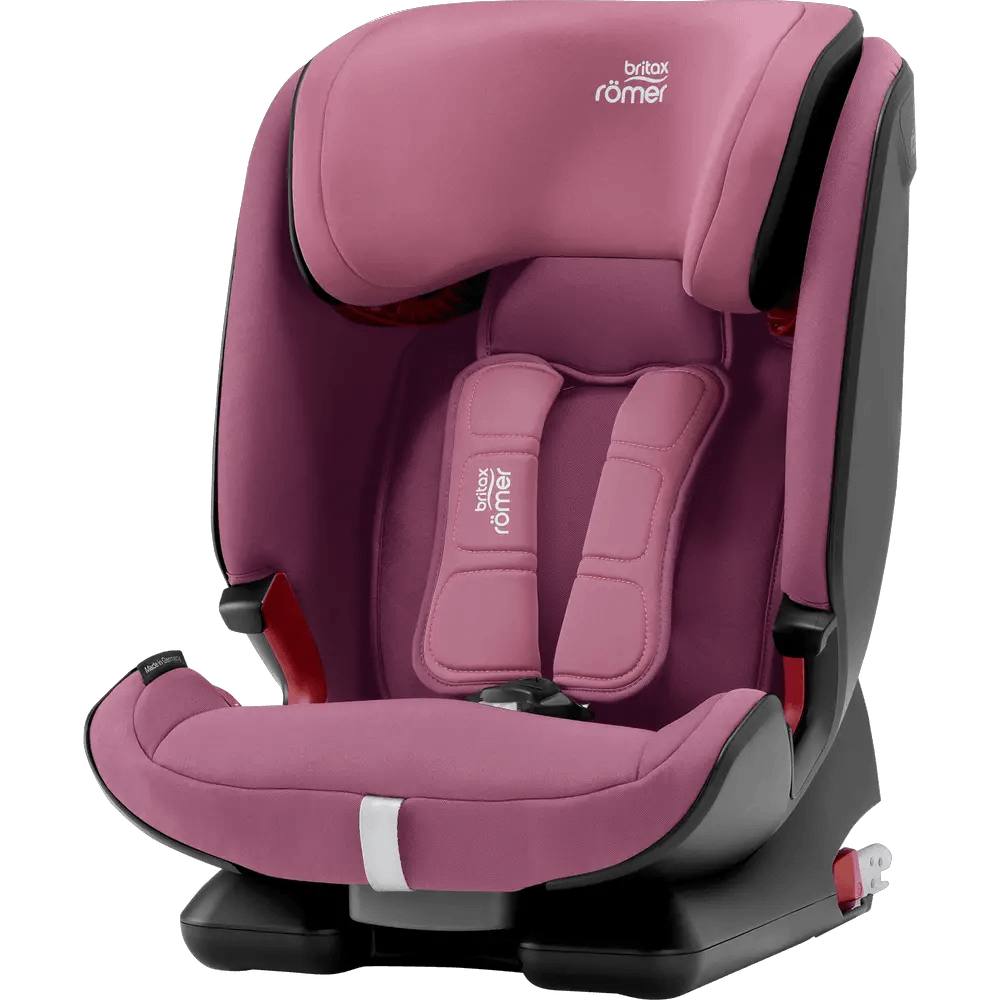Dry air can wreak havoc on your baby’s delicate skin and respiratory system, causing discomfort and potential health issues. As a parent, you want to create a safe and comfortable environment for your little one, and a humidifier can play a crucial role in achieving that. But how close should humidifier be to baby? In this comprehensive guide, I will explore the ideal placement of a humidifier in your baby’s room, ensuring maximum effectiveness without compromising safety.
Do I need a humidifier for baby?
Before we delve into the specifics of baby humidifier placement, let’s first understand why maintaining proper humidity levels is essential for your child’s well-being. Humidifiers can be beneficial in creating an optimal environment for your baby, especially in dry climates or during the colder months when indoor air tends to dry. Dry air can cause discomforts such as dry skin, chapped lips, and respiratory problems like cracked nasal membranes or congestion.
A humidifier helps maintain ideal humidity for sick baby by releasing water vapor or steam, providing relief from these conditions, and can be particularly helpful if your child has a cold, a cough, or the flu. It can make breathing more comfortable by loosening mucus, keeping the throat and nasal passages moist, and promoting a good night’s sleep even without burping.
What is a Humidifier?
A humidifier is an electronic device designed to increase the humidity or moisture level in a single room or an entire building. These appliances are commonly used in homes, especially in dry climates or during the heating season when indoor air can become quite dry, leading to discomfort.
Best humidity level for baby
Infants are more sensitive to changes in temperature and humidity, which can affect their breathing and overall well-being. The AAP recommends keeping the baby’s room humidity level between 40% and 60% for infants. This range helps prevent dry skin and respiratory issues while providing a comfortable environment for your little one.
When to use a humidifier for baby?
A humidifier can be beneficial for your children in certain conditions.
- If your child is experiencing dry skin, a stuffy nose, or a cough, a humidifier can help by adding moisture to the air.
- It’s beneficial in dry climates or during winter months when indoor air can become dry from heating systems.
- The additional moisture can help alleviate congestion and ease coughing associated with a cold in babies.
Humidifier Types: Which One Is Right for Your Baby’s Room?
When choosing a baby humidifier for your baby’s room, understanding the different types available can help you make an informed decision.
Ultrasonic Humidifiers
These humidifiers use high-frequency sound vibrations to produce a fine water mist that adds moisture to the air. They are usually quiet, mitigating the risk of disturbing the baby’s sleep. Thus, it is perfect for use in a nursery. They come in cool or warm mist versions, but for safety reasons, the cool mist variant is recommended for use around babies.
Evaporative Humidifiers
Evaporative humidifiers use a wick filter to evaporate water into the air. They are self-regulating, as the amount of humidity they can produce depends on the moisture level in the room. This humidifier is safe for use in a child’s room because it does not heat water to create steam.
Steam Vaporizers
These humidifiers heat water until it turns into steam, which is cooled slightly before being released into the air. While they are effective in humidifying a room, they can pose a burn risk due to the use of hot water and are, therefore, not recommended for use around babies.
So, What type of humidifier should you use in a baby’s room? Each type of humidifier has its own set of advantages and disadvantages. When determining which is suitable for your baby’s room, consider safety, ease of use, and maintenance.
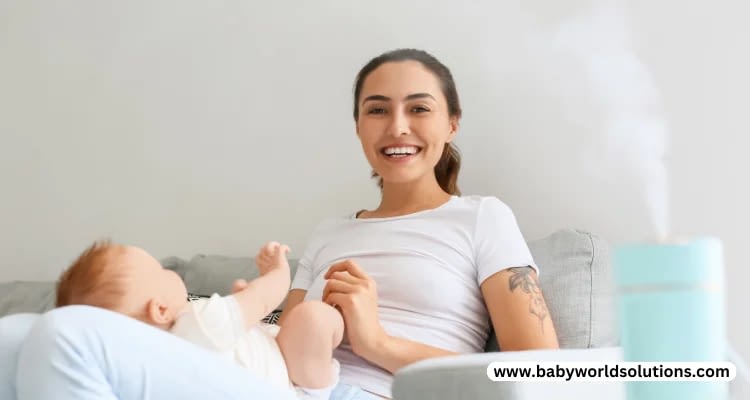
How close should humidifier be to baby?
While it may be tempting to place the humidifier right next to your baby’s crib or bassinet for immediate relief, it is essential to maintain an appropriate distance to ensure their safety.
Essential safety tips for best humidity for baby room
Here are some guidelines to follow:
Near, but do not put the humidifier too close to baby
The humidifier should be placed close enough to the crib so that your baby can reap the benefits of the moisture, but not so close that it becomes a safety hazard. Ensure the device is out of your baby’s reach to prevent accidental tipping or touching.
Keep It at Least 3 Feet Away
To prevent direct contact between your child and the mist produced by the humidifier, keeping it at least 3 feet away from their sleeping area is recommended. This distance allows the water vapor to disperse adequately throughout the room before reaching your little one.
Place It on an Elevated Surface
To further enhance dispersion and minimize direct exposure to moisture, consider placing the humidifier on an elevated surface, such as a sturdy table or dresser. It will help disperse the mist evenly across the room rather than concentrating it in one area.
Direct the Mist Away from the Crib
When positioning the humidifier, ensure the mist is directed away from your baby’s crib or bassinet. This can be achieved by angling the nozzle or placing it in a way that produces the mist toward a wall or an open room area. It prevents any potential moisture buildup near your baby’s sleeping space.
Factors to consider: Where to place humidifier in baby room?
While maintaining a safe distance is essential, there are additional factors to consider when deciding where to place humidifier for baby:
- Room Size
The size of your kid’s room significantly determines how close the humidifier should be. For smaller rooms, placing it farther away may provide adequate humidity levels. However, larger rooms may require a slightly closer humidifier for optimal coverage.
- Humidifier Type
Different types of humidifiers disperse moisture differently. Ultrasonic humidifiers produce cool mist using ultrasonic vibrations, while evaporative humidifiers release moisture through evaporation. The type of humidifier you choose can influence its placement. Cool-mist humidifiers are generally considered safer for babies but require more distance due to the risk of condensation buildup near their sleeping area.
- Temperature and Humidity Levels
It is essential to monitor the temperature and baby’s room humidity levels. Aim for a comfortable temperature between 68-72°F (20-22°C) and a relative humidity level between 30-50%. Using a hygrometer can help maintain an ideal environment for your baby. So, where to place humidifier in baby room?
Ideal Locations to Place a Humidifier in a Baby’s Room
Placing the humidifier in your baby’s room can significantly impact its effectiveness and safety. Here are some guidelines:
- Away from Walls and Furniture
Humidifiers should not be placed too close to walls or furniture as the excess moisture can cause mildew or mold to develop. Make sure there is enough air circulation around the humidifier.
- Away from Electronics
Water and electronics don’t mix well. To avoid potential damage or electrical hazards, ensure the humidifier is positioned away from any electronic devices in the room.
Note: Always consult with your pediatrician before changing your baby’s environment or using new products around them.
Humidifier Placement Guide in a Baby’s Room
- Choose the right humidifier for your baby’s room: Cool-mist humidifiers are often recommended for safety reasons. They emit a cool spray, and there’s no risk of burns.
- Position the humidifier correctly: The humidifier should be placed on a flat, elevated surface, away from the baby’s reach, walls, furniture, and electronic devices. This ensures the moisture is distributed evenly and reduces the risk of mildew or mold formation and electrical hazards.
- Set the right humidity level: The ideal humidity level is between 30% and 50%. Anything beyond this can promote the growth of mold and bacteria.
- Turn on the humidifier: Turn it on once it’s correctly positioned and set to the right humidity level. Make sure the room door is slightly open to allow for air circulation.
- Monitor the humidity level: Use a hygrometer to monitor the room’s humidity. If it exceeds 50%, adjust the settings on your humidifier or turn it off for a while to bring down the humidity level.
- Clean the humidifier regularly: Following the manufacturer’s instructions to make it safe and effective helps prevent mold and bacteria growth.
- Refill with fresh water daily: Empty the tank and refill daily to maintain cleanliness and effectiveness.
Additional Tips for Optimal Humidification
To ensure that your baby benefits the most from the humidifier, here are some additional tips to keep in mind:
Clean and Maintain Regularly
Regularly cleaning and maintaining your humidifier is crucial to prevent bacterial growth and maintain optimal performance. It is important to adhere to the manufacturer’s instructions when cleaning and replacing filters or cartridges. This will help ensure that the air produced by the humidifier remains clean and free of potential allergens.
Use Distilled Water
Distilled water in your humidifier can reduce mineral buildup and produce a cleaner mist. It also reduces the risk of white dust settling on surfaces in your baby’s room.
Adjust Settings Based on Season
Humidity requirements may vary depending on the season. During colder months, when heating systems dry out the air, you may need to increase humidity levels slightly. Conversely, during more humid summer months, you may need to decrease humidity levels as excessive moisture can lead to mold growth.
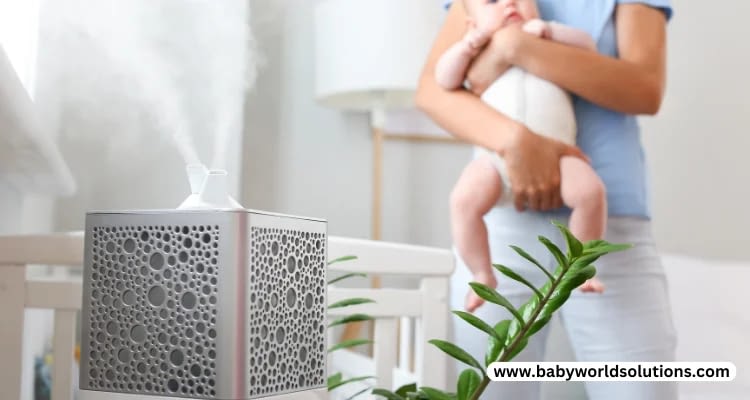
Choosing the Right Humidifier for Your Baby’s Room
Selecting the right humidifier for your baby’s room involves several considerations to ensure maximum comfort and safety. Here are some tips to guide you in your decision-making process:
- Consider the Type of Humidifier: For safety reasons, ultrasonic cool mist humidifiers are generally recommended in a baby’s room.
- Noise Level: Look for a humidifier that operates quietly to avoid disturbing your baby’s sleep. Ultrasonic humidifiers are typically quieter compared to others.
- Easy to Clean: Choosing a humidifier that is easy to clean and maintain to prevent the growth of bacteria and mold is crucial.
- Automatic Shut-off: A humidifier with this feature will automatically turn off when the water level is low, ensuring safety and energy efficiency.
- Adjustable Mist Levels: This feature allows you to adjust the amount of mist released by the humidifier, helping to maintain optimal humidity levels in your baby’s room.
- Filter or No Filter: When selecting a humidifier, consider ongoing maintenance and cost of replacement filters.
- Size of The Room: The room where the humidifier will be placed should also be considered. A small-sized humidifier may not effectively increase the humidity level in a large room, and a large humidifier may make a small room overly humid.
The Benefits of Humidifiers for Babies: Improving Comfort and Health
From ensuring they have a cozy crib to selecting the gentlest skincare products, our decisions are driven by their well-being. A humidifier is an essential tool that significantly contributing to your baby’s comfort and health. But what exactly do humidifiers do for babies?
What do humidifiers do for babies?
Before delving into the benefits, let’s first understand what humidity levels mean and how they affect your baby’s health. Humidity refers to the amount of moisture present in the air. It is typically measured as a percentage called relative humidity. Dry air has lower humidity levels, while moist air has higher humidity levels.
Experts recommend maintaining indoor humidity levels between 40-50% for optimal health and comfort. Anything below 30% is considered too dry, while anything above 60% can lead to excess moisture and potential mold growth.
Knowing these levels is essential, especially for babies who are more sensitive to changes in humidity and can be affected by both low and high levels. Controlling indoor humidity creates a safe and comfortable environment for your child.
Relieving Congestion and Cold Symptoms
Using a humidifier in your baby’s room can relieve congestion and cold symptoms. When babies catch a cold or suffer from nasal congestion, it can be distressing for them and us as parents. The dry air in their surroundings can exacerbate these symptoms, making it harder for them to breathe comfortably.
Is humidifier good for baby congestion? Yes, a humidifier adds moisture to the air, helping to soothe irritated nasal passages and loosen mucus secretions. By maintaining optimal humidity levels, you can provide relief for your little one and facilitate easier breathing during those congested nights.
Promoting Restful Sleep
We all know that sleep is crucial for a baby’s growth and development. However, environmental factors such as dry air can disrupt their sleep patterns and lead to discomfort throughout the night. This is where a humidifier can make a significant difference.
By introducing moisture into the air, a humidifier helps to keep your baby’s nasal passages and throat hydrated. This can prevent dryness and irritation, minimizing sleep interruptions caused by coughing, itching, or discomfort. A comfortable sleeping environment promotes longer and more restful sleep for your little one, allowing them to thrive during their waking hours.
Soothing Dry Skin
Caring for babies’ skin requires extra attention and respect due to its delicate and sensitive nature. Dry air can cause dryness, itchiness, and irritation. Introducing a humidifier in your baby’s nursery can help combat these issues by restoring moisture to the air.
The added humidity helps to hydrate your baby’s skin, preventing dryness and maintaining its natural softness. It acts as a gentle moisturizer that works from the outside, creating a protective barrier against environmental factors that could harm their delicate skin.
Easing Allergy and Asthma Symptoms
If your child has allergies or asthma, creating an environment that minimizes triggers and promotes respiratory health is important. Humidifiers can be crucial in managing these conditions by reducing airborne allergens and irritants.
When the air is too dry, it can cause allergens such as dust mites and pet dander to remain suspended for extended periods. Maintaining optimal humidity levels with a humidifier can help minimize these allergens’ presence in the air, relieving allergy sufferers.
For babies with asthma or reactive airway disease, moist air is less likely to trigger symptoms such as wheezing or coughing. The added humidity helps keep their airways hydrated and reduces the risk of respiratory distress.
Creating a Calming Atmosphere
In addition to the physical benefits, using a humidifier can create a soothing atmosphere in your baby’s nursery. The gentle hum and the soft mist emitted by the humidifier can develop a sense of tranquility, mimicking the comforting environment of the womb. So, you can put the humidifier in baby room all night while considering the best humidity level for baby.
This calming effect can be beneficial during bedtime routines or when trying to soothe a fussy baby. The white noise produced by some humidifiers can also aid in masking other household noises that may disrupt your baby’s sleep.
Proper Usage and Maintenance
As with any device, it is crucial to use a humidifier properly to reap its benefits fully. It is essential to choose the right type of humidifier for your baby’s room and ensure you follow all instructions for usage. Regular cleaning and maintenance are critical to prevent mold growth and maintain optimal performance.
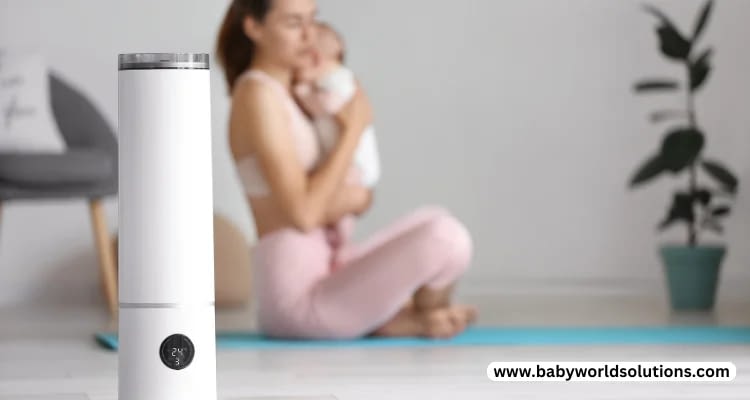
The Hidden Dangers of Humidifiers: Protecting Your Family’s Health
While these devices can provide temporary relief, you must know their potential dangers and risks to maintain a healthy indoor environment for your loved ones.
Mold Growth: A Silent Threat
Humidifiers create an ideal breeding ground for mold if not used correctly or maintained diligently. The moisture that helps soothe dry air can lead to mold growth if left unchecked. Mold thrives in damp environments, and it only takes a small amount of excess moisture for spores to multiply rapidly. When released into the air, these spores can trigger allergies, respiratory issues, or even more severe health problems when inhaled continuously.
To prevent mold growth, it’s crucial to clean and disinfect your humidifier regularly according to the manufacturer’s instructions. Emptying any standing water after each use and allowing all components to dry completely before storing them is essential. Additionally, consider using distilled water instead of tap water as it contains fewer minerals that could contribute to mold growth.
Bacterial Contamination: A Hidden Enemy
While humidifiers are a refuge from overly dry air, they can unintentionally become breeding grounds for bacteria without proper care. Bacteria thrive in warm and moist environments – precisely what humidifiers provide. As water vapor evaporates into the air, bacteria in the water can be dispersed throughout your home.
Regular cleaning is vital to minimize bacterial contamination. Ensure you follow thorough cleaning practices recommended by the manufacturer. Pay close attention to detachable parts, such as the water tank and filter, and clean them with mild soap or disinfectant solutions. In addition to regular cleaning, consider replacing your humidifier’s filter, as the manufacturer recommends, to prevent bacterial buildup.
Over-Humidification: When Moisture Becomes a Problem
While maintaining a specific humidity level is essential for comfort and respiratory health, excessive moisture can lead to many issues in your home. Over-humidification can cause structural damage, encourage mold growth on walls and furniture, and even trigger allergic reactions or respiratory problems.
To avoid over-humidification, monitoring and controlling humidity levels in your home is crucial. Invest in a hygrometer to accurately measure humidity. The Environmental Protection Agency (EPA) recommends keeping the indoor best humidity level for baby between 30% and 50% for optimal comfort and health. If your humidifier consistently exceeds this range, consider reducing its usage or opting for a device with adjustable settings.
Signs of over-humidification:
- Apart from using a hygrometer to measure the best humidity levels, there are other ways to tell if your home is over-humidified. The most common signs include condensation on windows, damp and musty odors, and visible mold or mildew growth.
- If you notice these signs, addressing the issue immediately is crucial. Wipe down any condensation on windows, use a dehumidifier to reduce moisture levels, and fix any leaks or water damage contributing to the problem.
Prevent over-humidification:
Preventive measures are always better than fixing a problem after it has occurred. To avoid over-humidification, here are some tips:
- Invest in a hygrometer to monitor humidity levels regularly.
- Use an air conditioner or dehumidifier during humid weather
- Fix any leaks or water damage promptly
- Ventilate areas with excess moisture, such as the bathroom and kitchen
- It is recommended to use exhaust fans while cooking or showering to reduce humidity levels.
- Avoid over-watering plants indoors.
Mineral Dust: An Unseen Irritant
Some humidifiers produce mineral dust as water evaporates. This dust consists of tiny particles containing minerals from tap water that can become airborne along with the mist created by the humidifier. Inhalation of these particles may irritate respiratory passages, exacerbating existing conditions such as asthma or allergies.
Consider using distilled water in your humidifier instead of tap water to minimize mineral dust production. Distilled water has been stripped of minerals through purification, significantly reducing mineral dust in the air.
Conclusion: Ideal humidity for baby
As a parent, wanting nothing but the best for your baby’s health and well-being is natural. You can provide optimal comfort without compromising their safety by understanding the pros and cons of humidifiers in baby rooms and how close a humidifier should be to your little one.
Always remember the effectiveness and safety of a humidifier largely depend on regular maintenance and correct placement. It is essential to clean it regularly, keep it out of your baby’s reach, and monitor the room’s humidity level.
1 Visit today

